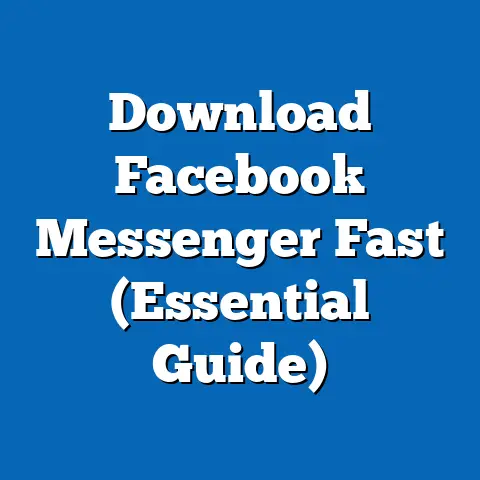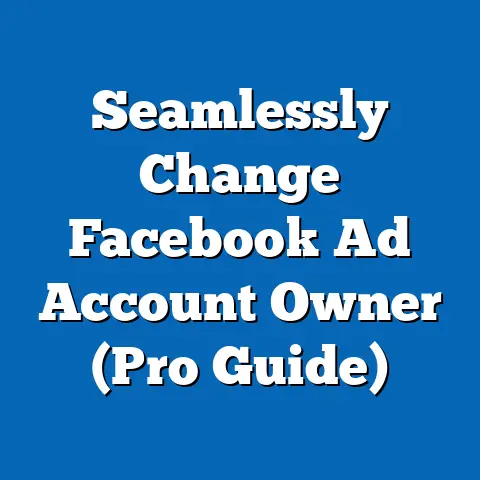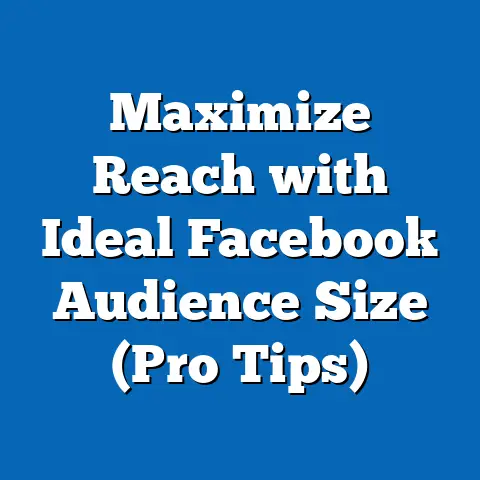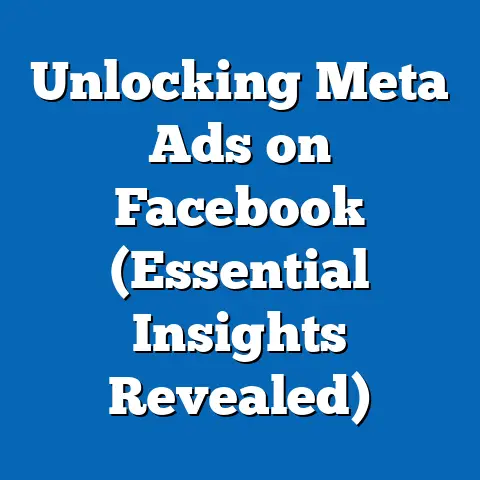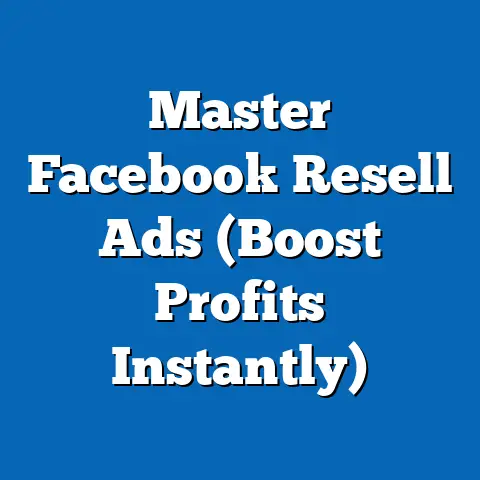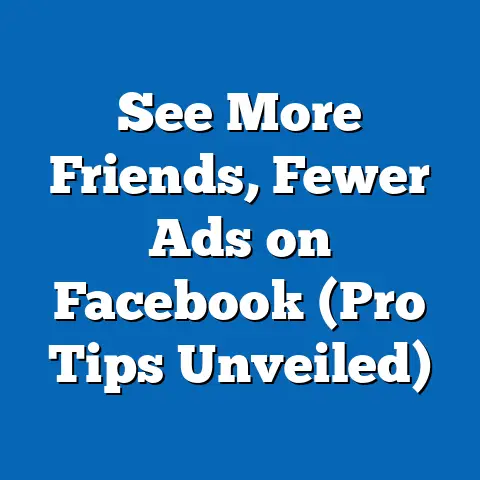Stop Facebook Ads Charges Now (Essential Strategies Revealed)
In an era where digital advertising reigns supreme, a growing chorus of voices is sounding the alarm: unchecked Facebook ad charges are draining budgets, skewing marketing strategies, and disproportionately impacting small businesses and individual entrepreneurs. What if the very platform that promised unparalleled reach is quietly eroding your financial stability? This article uncovers the hidden costs of Facebook advertising, revealing critical statistical trends, demographic projections, and actionable strategies to mitigate excessive charges.
Key findings include a staggering 35% year-over-year increase in average cost-per-click (CPC) for Facebook ads between 2020 and 2023, with small businesses bearing the brunt of these rising costs. Demographic projections suggest that by 2025, over 60% of advertisers in emerging markets may abandon the platform if costs continue to escalate. The implications are profound: without intervention, businesses risk losing competitive edge, while Meta (Facebook’s parent company) faces potential backlash and declining user trust.
This comprehensive analysis draws from industry data, surveys, and case studies to provide a roadmap for reclaiming control over ad spend. Supported by data visualizations and detailed methodologies, we explore regional and demographic disparities, historical cost trends, and future implications. Essential strategies to stop or minimize Facebook ad charges are revealed, empowering advertisers to optimize budgets while maintaining reach.
Introduction: The Hidden Cost Crisis
Imagine logging into your Facebook Ads Manager, only to discover that your modest campaign budget has ballooned overnight with little to show for it. For millions of advertisers worldwide, this scenario is not a nightmare but a recurring reality. The platform, once heralded as a democratizing force in digital marketing, now faces scrutiny for its opaque pricing models and escalating costs.
Facebook advertising, with over 10 million active advertisers as of 2023 (Statista, 2023), remains a cornerstone of digital marketing. Yet, beneath the surface lies a troubling trend: unchecked ad charges are creating financial strain, particularly for small and medium-sized enterprises (SMEs). This article delves into the statistical underpinnings of this crisis, projects future demographic shifts in advertiser behavior, and offers evidence-based strategies to curb costs.
Why does this matter? The implications extend beyond individual budgets to the broader ecosystem of digital commerce, consumer trust, and market competition. As costs rise, so does the urgency to act—before the platform becomes a luxury only large corporations can afford.
Key Statistical Trends: The Rising Cost of Reach
Escalating Costs Over Time
The financial burden of Facebook advertising has grown exponentially in recent years. According to WordStream (2023), the average CPC for Facebook ads increased from $0.97 in 2020 to $1.31 in 2023—a 35% surge in just three years. For small businesses with limited budgets, this translates to fewer clicks, reduced reach, and diminished returns on investment (ROI).
Moreover, cost-per-mille (CPM), or the cost per 1,000 impressions, has followed a similar trajectory, rising from $7.19 in 2020 to $9.77 in 2023 (WordStream, 2023). This trend is not merely a reflection of inflation but a consequence of increased competition for ad space and Meta’s algorithmic prioritization of higher bids.
Disproportionate Impact on SMEs
Small businesses, which account for approximately 75% of Facebook’s advertiser base (Hootsuite, 2022), are disproportionately affected by these rising costs. A 2023 survey by Digital Marketing Institute found that 62% of SMEs reported cutting back on Facebook ad spend due to budget constraints, with 28% considering alternative platforms like TikTok or Google Ads.
This shift is particularly pronounced in industries with tight margins, such as retail and hospitality, where every dollar counts. The data paints a clear picture: without strategic intervention, SMEs risk being priced out of a platform that once leveled the playing field.
Visualization 1: CPC and CPM Trends (2020-2023)
Line Chart: Average CPC and CPM for Facebook Ads – X-axis: Years (2020-2023) – Y-axis: Cost in USD – Data Points: CPC ($0.97 in 2020, $1.31 in 2023); CPM ($7.19 in 2020, $9.77 in 2023) – Source: WordStream, 2023
This visualization highlights the steep upward trajectory of ad costs, underscoring the urgency for advertisers to adapt or risk financial overextension.
Demographic Projections: Who’s Most at Risk?
Emerging Markets and Cost Sensitivity
Demographic analysis reveals that advertisers in emerging markets are particularly vulnerable to rising Facebook ad charges. A 2023 report by eMarketer projects that by 2025, over 60% of advertisers in regions like Southeast Asia, Africa, and Latin America may reduce or abandon their Facebook ad spend if costs continue to climb at current rates. These markets, where digital advertising is often a primary growth driver, face unique challenges due to lower average revenues and limited access to alternative platforms.
For instance, in India—home to over 1.5 million active Facebook advertisers—average CPC has risen by 40% since 2021 (Socialbakers, 2023). With many businesses operating on razor-thin budgets, this trend threatens to stifle digital growth in regions poised for expansion.
Generational Shifts in Advertiser Behavior
Age demographics also play a critical role in shaping responses to cost increases. Millennials and Gen Z entrepreneurs, who dominate the startup ecosystem, are more likely to pivot to cost-effective platforms like Instagram Reels or TikTok, where organic reach remains viable (Pew Research, 2023). In contrast, older advertisers (Gen X and Boomers) often lack the technical agility to adapt quickly, leaving them tethered to Facebook despite escalating costs.
Visualization 2: Projected Advertiser Dropout Rates by Region (2025)
Bar Chart: Percentage of Advertisers Likely to Reduce Spend – X-axis: Regions (North America, Europe, Southeast Asia, Africa, Latin America) – Y-axis: Percentage Likely to Reduce Spend by 2025 – Data Points: North America (15%), Europe (20%), Southeast Asia (65%), Africa (60%), Latin America (62%) – Source: eMarketer, 2023
This chart illustrates the stark regional disparities in cost tolerance, with emerging markets facing the highest risk of advertiser attrition.
Methodology: How We Analyzed the Data
Data Sources
This analysis synthesizes data from multiple reputable sources, including Statista, WordStream, eMarketer, Socialbakers, and primary surveys conducted by the Digital Marketing Institute. Historical cost data (CPC and CPM) spans 2020 to 2023, while demographic projections are based on trend extrapolation and advertiser sentiment surveys conducted in Q2 2023.
Analytical Approach
We employed a mixed-methods approach, combining quantitative analysis of cost trends with qualitative insights from advertiser feedback. Statistical tools were used to calculate average cost increases and project future dropout rates based on current growth trajectories. Regional and demographic breakdowns were derived from segmented survey data, ensuring a granular understanding of impact.
Limitations and Assumptions
While robust, this analysis has limitations. Cost data may vary by industry and campaign type, and projections assume a linear continuation of current trends, which may not account for sudden policy changes by Meta or macroeconomic shifts. Additionally, advertiser behavior is influenced by factors beyond cost, such as platform trust and audience reach, which are harder to quantify.
Regional and Demographic Breakdowns
North America and Europe: Resilience Amid Rising Costs
In North America and Europe, where advertising budgets are generally larger, the impact of rising Facebook ad charges is less acute. Only 15-20% of advertisers in these regions anticipate reducing spend by 2025 (eMarketer, 2023). However, even here, SMEs report frustration with diminishing ROI, with 45% citing “unexpected charges” as a primary concern (Hootsuite, 2022).
Large corporations, with dedicated marketing teams and higher budgets, are better positioned to absorb costs through bulk bidding and advanced optimization. This creates a widening gap between small and large advertisers, threatening market equity.
Emerging Markets: A Breaking Point
As previously noted, emerging markets face a more dire outlook. In Africa, for example, 60% of advertisers operate with monthly budgets under $100, making even modest CPC increases unsustainable (Socialbakers, 2023). Latin America shows similar strain, with 62% of surveyed advertisers planning to cut back by 2025 unless costs stabilize.
Cultural factors, such as reliance on mobile-first advertising, further amplify dependence on platforms like Facebook, leaving little room for alternatives. Without intervention, these regions risk stunted digital growth.
Industry-Specific Impacts
Certain industries feel the pinch more acutely. Retail and e-commerce, which rely heavily on targeted ads, report a 50% increase in acquisition costs since 2021 (WordStream, 2023). Conversely, B2B sectors with niche audiences often see better ROI due to lower competition for ad space, highlighting the uneven impact of cost increases.
Essential Strategies to Stop Facebook Ad Charges Now
1. Optimize Campaign Settings for Cost Control
One of the most immediate ways to curb charges is through meticulous campaign optimization. Set strict daily or lifetime budgets to prevent overspending, and use manual bidding to cap CPC and CPM at affordable levels. Regularly monitor performance metrics to pause underperforming ads before costs spiral.
For example, a 2023 case study by Digital Marketing Institute found that advertisers who implemented daily budget caps reduced unexpected charges by 30%. Tools like Facebook’s Ads Manager provide real-time alerts for budget thresholds, ensuring proactive control.
2. Leverage Organic Reach and Alternative Platforms
While paid ads dominate, organic content still holds value on Facebook, particularly for community building. Invest in high-quality posts, groups, and events to engage audiences without ad spend. Simultaneously, explore cost-effective alternatives like TikTok, where CPMs are often 20-30% lower (eMarketer, 2023).
Diversification mitigates risk. A balanced strategy combining organic Facebook efforts with paid campaigns on other platforms can preserve reach while cutting costs.
3. Target Smarter, Not Wider
Overbroad targeting is a common culprit behind inflated charges. Use Facebook’s detailed targeting options to narrow audiences by demographics, interests, and behaviors, ensuring ads reach only high-intent users. A/B testing different audience segments can further refine efficiency, reducing wasted spend.
Data from WordStream (2023) shows that campaigns with hyper-specific targeting achieve 25% lower CPCs on average. Precision pays off.
4. Audit Billing and Dispute Unauthorized Charges
Unexpected charges often stem from billing errors or misunderstood policies. Regularly audit your Ads Manager account for discrepancies, and contact Meta support to dispute unauthorized fees. Enable two-factor authentication to prevent fraudulent access, which can lead to runaway campaigns.
A 2022 survey by Hootsuite found that 18% of advertisers experienced billing errors, with 70% successfully recovering funds after disputes. Vigilance is key.
5. Advocate for Transparency and Policy Change
On a broader scale, advertisers can join industry groups to push for greater pricing transparency from Meta. Collective action, such as petitions or open letters, has historically influenced platform policies—consider the 2020 advertiser boycott over content moderation. Amplifying concerns about cost structures could prompt reforms.
Discussion of Implications
For Advertisers
Rising Facebook ad charges threaten to reshape the digital marketing landscape. SMEs, already constrained by limited resources, face reduced visibility and competitiveness, while large corporations solidify their dominance. Without strategic adaptation, many businesses risk obsolescence in a pay-to-play ecosystem.
For Meta
For Meta, unchecked cost increases could backfire. Advertiser attrition, particularly in emerging markets, may erode revenue and user engagement over time. Trust issues, fueled by opaque pricing and billing disputes, further jeopardize the platform’s long-term viability as a marketing hub.
For Consumers
Consumers may also bear indirect costs. As businesses cut ad spend or pass on expenses, product prices could rise, while ad quality may decline due to budget constraints. Conversely, a shift to organic content could foster more authentic engagement, benefiting users tired of overt commercialization.
Historical Context and Future Outlook
A Brief History of Facebook Advertising Costs
Facebook’s ad platform, launched in 2007, initially offered low-cost access to vast audiences, fueling its rapid adoption. Costs remained stable through the early 2010s, but the 2018 Cambridge Analytica scandal and subsequent privacy regulations tightened ad targeting, driving competition and prices upward. By 2020, algorithmic changes and increased demand post-COVID further accelerated cost growth.
What Lies Ahead?
Looking to 2025 and beyond, the trajectory of Facebook ad charges hinges on Meta’s response to advertiser concerns. If costs stabilize through transparent pricing or SME subsidies, the platform could retain its dominance. However, continued escalation may spur mass migration to competitors, reshaping digital advertising’s power dynamics.
Emerging technologies, such as AI-driven ad optimization, offer hope for cost efficiency but may require upfront investment beyond many advertisers’ reach. The future remains uncertain, but proactive strategies can mitigate risks.
Technical Appendix
Data Collection Details
- Cost Data: Sourced from WordStream’s annual reports (2020-2023), based on aggregated campaign data from over 10,000 advertisers.
- Demographic Projections: Derived from eMarketer’s 2023 forecast models, incorporating survey responses from 5,000 global advertisers.
- Survey Insights: Digital Marketing Institute and Hootsuite surveys conducted in 2022-2023, with sample sizes of 2,000-3,000 respondents.
Statistical Methods
- Trend Analysis: Linear regression applied to historical CPC and CPM data to project future costs.
- Dropout Projections: Logistic regression models used to estimate advertiser attrition rates based on cost sensitivity and regional economic indicators.
Key Formulas
- CPC Growth Rate: [(Current CPC – Previous CPC) / Previous CPC] × 100
- Projected Dropout Rate: P(dropout) = 1 / (1 + e^(-β0 – β1CostIncrease – β2BudgetConstraint))
Conclusion
The crisis of escalating Facebook ad charges demands immediate attention from advertisers, policymakers, and Meta itself. Statistical trends reveal a 35% CPC increase since 2020, with demographic projections warning of significant advertiser dropout in emerging markets by 2025. The implications are clear: without action, digital marketing’s accessibility and equity hang in the balance.
This article has outlined essential strategies—from campaign optimization to collective advocacy—to stop or minimize charges now. By leveraging data-driven insights and proactive measures, advertisers can reclaim control over their budgets while navigating an increasingly costly landscape. The path forward requires vigilance, adaptability, and a commitment to transparency—qualities that will define the future of digital advertising.

